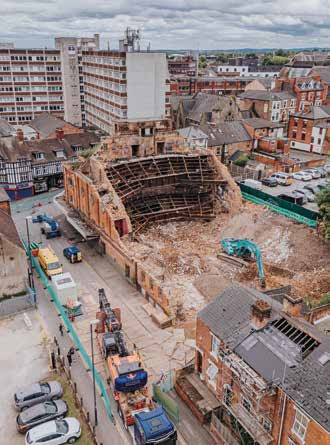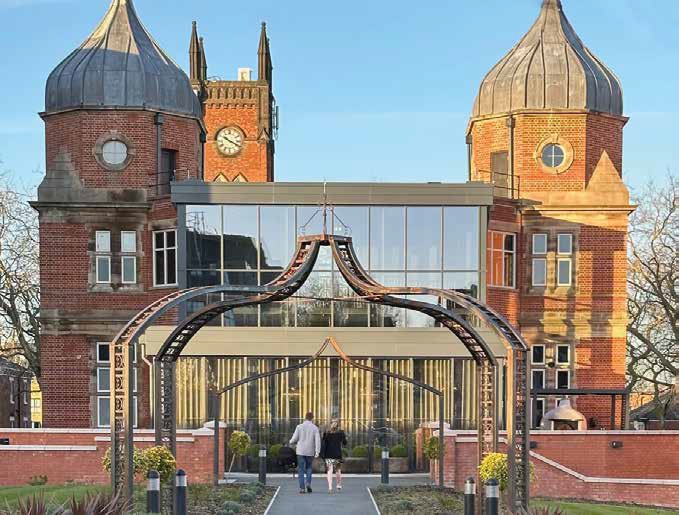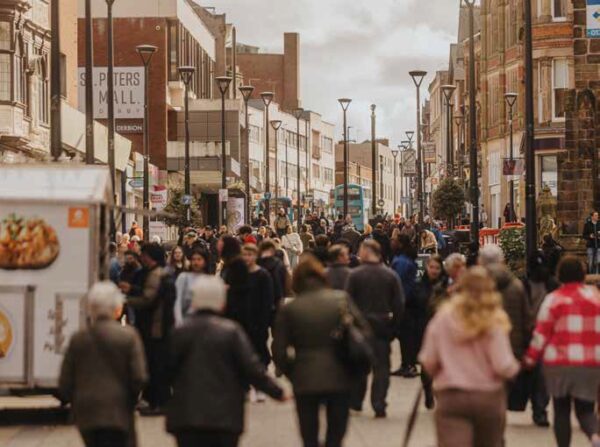Blog | 9 July 2025
And so, the Derby Hippodrome may soon be no more…

As I write this, news is in that Derby City Council has initiated ‘emergency planning’ powers and employed bulldozers to finally demolish this tired, rundown (and, in the end, dangerous) Grade 2 listed structure in the city’s Green Lane, reports Marketing Derby’s managing director John Forkin.

Its most recent death sentence was signed off by proverbial ‘Health & Safety’, as the structure became increasingly subjected to repeated vandalism and fires, posing a danger to the neighbourhood.
The decline of this 2,600 capacity theatre – which during its heyday hosted hundreds of performers, from Tommy Cooper and Ken Dodd, to Bella Lugosi’s Dracula – really started when the promise of ‘a TV in every home’ threatened its core purpose as a popular ‘music hall and palace of varieties’.
In 1959 the building was closed.
Hippodrome life since then has been a mix of bingo and intermittent closures before eventually falling foul to a botched semi-demolition in 2007, one that left it totally exposed to the elements and its inevitable consequences.
It’s a sad tale of changing times and tastes, poor ownership, in a Cinderella part of the city that has traditionally fallen outside of the focus of regeneration initiatives.
More recently a well-intentioned Restoration Trust was desperately trying to create a new vision for the building’s use as a music venue but in the end, it looks like the sheer scale of resource required (at least tens of millions) pitched the plans in a race against the harsh clock of dereliction. There was only ever going to be one winner.
The week that saw the further demolition of that 2,600 venue, also saw, a mere 100 yards away, the opening of the impressive 3,500 capacity Vaillant Live performance venue. Its grand stage will soon to be graced by the likes of Rag’n’Bone Man, the Simple Minds and the Blossoms.
The story of the Hippodrome throws up many issues, not least that of the dynamic between heritage and regeneration.
This tension has been exercised in all cities as they grapple with the need to respect and protect the past, whilst allowing breathing space for building the future.
Like the Assembly Rooms, the Hippodrome has been the subject of two opposite forces – to save or to redevelop – the result of which has been a decade of stasis to the detriment of the city. The tendency is for things in the ‘too difficult’ box to be kicked down the road.

Across the world there are famous battles that manifested this conundrum on a massive scale.
The demolition of Penn Street and consequent saving of Grand Central rail stations in New York City may be one of the highest profile internationally, whilst the equivalent closer to home, would be the demolition of Euston followed by the saving of St Pancras.
These decisions cast a long legacy, as witnessed over half a century later by contrasting the appalling mess around Euston today with the elegance of St Pancras, still standing only a mere few hundred yards away, replete with that fitting statue of poet-cum campaigner, Sir John Betjeman.
Both examples led to a rethinking of how best to protect heritage including the adoption of legislation as a legal framework and the creation of a myriad of quangos and lobby groups focused on the theme.
Today city developments have inherited that legacy, good and bad.
When developers are submitting planning applications for new schemes, they have had to learn how to navigate the interests not only of planning officers but also a jumble of groups such as Historic England, Natural England, Civic Society, Conservation and Heritage Advisory Committee, Victorian Society, 20th Century Society et al.
A city like Derby is lucky to have an historical core with number of listed buildings and extensive designated Conservation Areas. By their nature these are a good thing and should contribute to an attractive city.
I say ‘should’ because, as next time you are in town, take a walk around and look up to the upper floors of buildings and you will quickly see how in many cases the once beautiful has been allowed to decline. Many buildings have been unoccupied for 50+years, windows are rotted and vegetation creeps out from roofscapes.
The harsh truth is that the state of much of our city’s heritage – from Queen St to Friar Gate Bridge, Becket St to the Cornmarket – is shameful and as each year of decline passes the cost of refurbishment grows. Over decades, landlords have allowed this decline to happen to their properties in an absence of enforcement by the authorities.
And yet, at the same time, there are significant acres of derelict land in pockets spread across the city centre which could host new developments, which if brough forward could help the city move forward.
It’s important to remember that new developments bring much needed cash into the city’s coffers, be it via Section 106 development payments, new business rates or Council Taxes.
There are signs of hope.

The speed and success of the Nightingale Quarter with its 925 homes and refurbishment of the two Pepper Pots is one example. By my estimation, those homes will generate well over £1million in Council Tax each year.
The developer Wavensmere Homes has gone a stage further and has taken on the task that proved impossibly scary for over 50 years, that is the development of the Friar Gate Goods Yard into 250 homes and a 100,000 sq ft of commercial uses.
The City Council’s recent stunning £35m refurbishment of the Victorian Market Hall uncovers a much-loved icon and is worth every penny.
Derby is attracting UK and international attention with investors and the city centre’s darkest day may well be behind us.
Success requires inward investment to be welcomed not resisted; for the heritage community to shift attention away from perceived impacts of new developments to focus on tangible actions that save existing heritage assets; and for the city authorities use its powers and funding to show lax landlords both the sticks of enforcement and the carrots of regeneration.
In my view, there is a sweet spot with the possibility of a positive synergy between investment and heritage and that is the regeneration that Derby needs.

